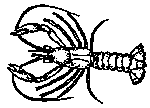Common Freshwater Organisms

Mosquito fish. Fish Up to 2 1/2"
They live in ditches, ponds, and lakes eating mosquito larvae and other insects. Mosquito fish give birth to live young.

Tadpole. Amphibian. 1/8 to 3"
Tadpoles are young frogs and toads. They eat algae and decaying aquatic plants.

Crawfish or Crayfish.Crustacean. Up to 6"
Crayfish live in and around water. They feed on both plants and animals. When burrowing, crayfish produce mud "chimneys".

Fairy Shrimp. Crustacean. 1/3 to 1"
They are usually found in shallow, temporary pools. Fairy shrimp feed by filtering animals and plants from the water while swimming on their back.

Copepods.Crustacean. Almost microscopic
Some copepods are filter-feeders, some seize and bite their prey, and others scrape food from the bottom of the pond or stream.

Scuds.Crustacean. Up to 3/4"
Also called "sideswimmers", they are scavengers, feeding on decaying plant and animal material. The scud is usually found near the bottom of a pond or under vegetation. They look like large fleas.

Isopods. Crustacean. Up to 3/4"
Isopods eat dead animals and living or dead plants. They are found under rocks and plants.
![]() Seed Shrimp. crustacean. Pinhead sized
Seed Shrimp. crustacean. Pinhead sized
Seed Shrimp look very similar to small clams but they are fast swimmers. They eat dead plant and animal material.

Water Mites. Arachnid. Pinhead sized
Water Mites are usually red and look like tiny spiders. The eat plants and animals.
Clams. Mollusk. 1/4 to 1 1/2"
Clams burrow into the mud leaving one end sticking out to filter feed. They are found in rivers, lakes and ponds.
Snails. Mollusk. 1/4 to 1"
Snails eat diatoms, plants, and algae. Some of them breathe air from a "lung," an air-filled cavity so they can live in water with little oxygen.

Diving Beetle. Insect. 1/4 to 2"
They trap air under their wings to breathe underwater. Diving beetles eat small aquatic animals. Their bite is painful.

Water Boatman. Insect. Up to 1/4"
They must carry an air bubble to breathe underwater. The air bubble surrounds the insect giving it a silvery appearance. Water boatmen feed on both plants and animals.

Backswimmer. Insect. 1/2"
To breathe underwater, they carry a bubble of air beneath their wings. Backswimmers swim on their back searching for small animals to eat. These insects are similar to water boatmen but twice as big.

Damselfly Nymph. Insect. 1/4 to 1"
This is a young damselfly. It is often confused with the dragonfly nymph but it has three gills on the end of the abdomen. It eats small animals.

Dragonfly Nymph. Insect. 1/4 to 1"
This is a young dragonfly. Unlike the damselfly nymph, its gills are located on the inside of its body. It eats small aquatic insects, worms, crustaceans and fish.

Mayfly Nymph. Insect. 1/4 to 1"
These are young mayflies. They have 2-3 tail parts. Mayfly nymphs feed on small plants, and animals and sometimes scavenge.

Giant Water Bug. Insect. 1 1/2 to 3"
They eat animals as large as tadpoles and small fish. Giant water bugs kill their prey by secreting a poison when they bite. The male carries his future children on his back, when they are still eggs. Nicknamed "toebiters," because their bite is painful.

Mosquito Larvae. Insect. 1/8 to 1/2"
These young mosquitoes hang by a breathing tube from the water surface. Mosquito larvae feed on tiny plants and animals while the adult mosquitoes feed on nectar and ripe fruit. However, female mosquitoes also feed on the blood of animals.
Midge Fly Larvae. Insect. Up to 1/4"
They are young midge flies. They are worm-like with two tiny legs on each side.

Water Scorpion. Insect. Up to 3"
The water scorpion breathes air underwater by projecting a breathing tube through the water's surface to the air. Water scorpions are predators seizing small aquatic organisms with their front legs. Their bite is painful.

Waterstrider or Pondskater. Insect. 1/4 to 1"
These insects skate on top of the water's surface. They feed on insects or small crustaceans caught just below the surface. Waterstriders are often seen in large groups.